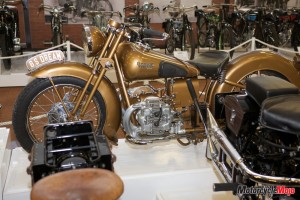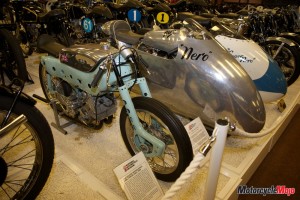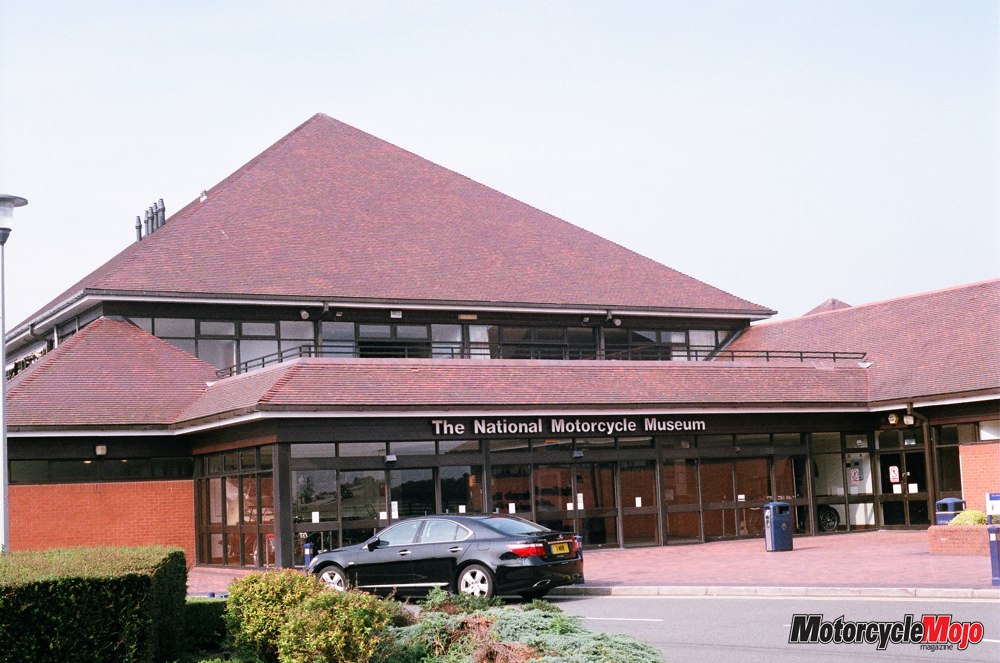Just as Britannia once ruled the waves, Britain once ruled the world’s motorcycle industry. While it is inevitable that every dynasty eventually falls, the memory must remain alive.
Late this past summer, while I was on holiday in England, I took advantage of the opportunity to spend a day at Britain’s National Motorcycle Museum in Solihull, near Birmingham, in the Midlands. It was truly a day well spent.
Britain, like Germany, France, Italy, the United States and a number of other countries, has a rich motorcycle history spanning more than a century and including over a hundred companies. Without a doubt, the National Motorcycle Museum’s thousand-machine collection exemplifies that history.
As with America’s Barber Museum, the British institution owes its existence to one man, W.R. (Roy) Richards, a hugely successful construction-industry entrepreneur who was passionate about British motorcycles and particularly fond of Nortons. Mr. Richards, who passed away in 2008, began purchasing good-condition British motorcycles in the 1970s, and by the early 1980s, his personal collection had grown to include over 300 machines.
Richards viewed his bike collection as a tribute to the British motorcycle industry, which was a world leader in many respects from the 1930s to the 1960s. It was this history that prompted him to establish the National Motorcycle Museum, opening his private collection to the public in recognition of the motorcycle industry’s important place in Britain’s heritage.
 The museum opened its doors in 1984 with 350 machines on display. The following year, conference facilities were added to increase the museum’s public profile and to expand the revenue base to support the museum’s operations. Additional machines were acquired each year, including a mix of ordinary, rare and historically significant bikes.
The museum opened its doors in 1984 with 350 machines on display. The following year, conference facilities were added to increase the museum’s public profile and to expand the revenue base to support the museum’s operations. Additional machines were acquired each year, including a mix of ordinary, rare and historically significant bikes.
By 2003, the museum collection had grown to 650 bikes, making it the largest collection of British motorcycles in the world. That’s when disaster struck. On the afternoon of September 16, a little before 5 p.m., a discarded cigarette started a fire in Hall 5 that spread rapidly, rising above the facility’s suspended ceiling and spreading quickly to adjoining halls.
The building’s fire alarm system quickly sounded the alert and notified the local fire services, but there was no sprinkler system in place to slow the fire’s pace. Fortunately, a conference was underway at the museum, and when the alarms sounded, many attendees pitched in to assist the museum staff in saving about 300 bikes.
By the time the fire had been put out, three of the five exhibit halls had been burned out, and some 350 bikes had been damaged, both by the fire and by falling roof tiles, some irreparably. Among these were many machines of unique provenance and historic significance, lost for all time.
According to well-known British author and moto-journalist Mick Duckworth, who was kind enough to help with this article, Richards was devastated by the tragedy, but doggedly determined to rebuild, and at a record pace. The total damages and losses sustained amounted to an estimated £14 million ($30.6 million Canadian). Richards pressed for a rapid insurance settlement and immediately set to work restoring or replacing bikes lost to the fire. His museum would rise from the ashes like the proverbial phoenix. The recovery project, which some had said would take three to four years, was completed in a little over 14 months at a cost of 20 million pounds ($48 million), including $2.9 million spent on a state-of-the-art sprinkler system.
The museum’s own internal restoration team, namely Colin and Wesley Wall, worked diligently to restore bikes for the reopening, and continue to do such work for the museum. In addition, many irreplaceable motorcycles that could be restored were handed over to acknowledged experts to carry out the task. This included some of the museum’s impressive collection of BSA/Triumph works road-racing triples, which Mick says were “rebuilt by a small team of ex-factory men who were involved with the original builds in the 1970s.”
All told, when the museum reopened on December 1, 2004, the motorcycles on display included those that had escaped the fire, many previously damaged bikes that had been fully restored, plus a mix of recently acquired machines to replace those that were either beyond repair or cheaper to replace than fix. According to Mick, an estimated 120 of the fire-damaged motorcycles are now back on display in pristine condition.
 When you first enter the museum’s reception area you see Nortons, especially to your right, where you will find an impressive line-up of ’60s and ’70s racing twins, including white John Player factory bikes that were raced by the likes of Peter Williams, Dave Croxford and others.
When you first enter the museum’s reception area you see Nortons, especially to your right, where you will find an impressive line-up of ’60s and ’70s racing twins, including white John Player factory bikes that were raced by the likes of Peter Williams, Dave Croxford and others.
Richards was passionate about Nortons. According to Simon Hartland, one of Richards’ three stepsons and the current curator of the museum, his favourite saying was, “When God made the mountains, he had Nortons in mind.”
The museum’s collection is truly awesome. All of the machines on display are British, but that includes a number of foreign-built racing machines, as well as some earlier, 1900s motorcycles powered by engines made in other countries, such as Belgium, France and Switzerland.
Examples on display include the Texas-built 650 cc Triumph streamliner on which Texan Johnny Allen recorded 193 mph (311 km/h) on the Bonneville Salt Flats in 1955, and the Peugeot-powered NLG (North London Garages) V-twin that won the very first motorcycle race at Brooklands in 1908. The NLG was seriously fire-damaged in 2003, but was restored and then ridden at Brooklands in 2008 to mark the 100th anniversary of its historic win.
The collection includes both ordinary and up-market streetbikes large and small, dual-purpose and off-road machines, sidecar outfits and early quad bikes, police, road service and military models, all manner of competition bikes, prototypes and custom-built specials spanning a hundred years and including dozens of different marques. The quantity and quality of the machines on exhibit is remarkable.
One hall has a whole series of street machines lined up in chronological order, with different makes and models for each year, to visibly illustrate the technical evolution of British motorcycles. I saw many bikes that were special to my dad, such as the 350 cc Excelsior Manxman and the Grand Prix Triumph 500, bikes I heard about as a youth.
Walking from hall to hall, I was constantly wowed to find yet another special bike. Entering through one doorway, I discovered the famous prototype 1000 cc Triumph Quadrant OHV four. It was parked along with five other good-looking 1960s and early ’70s prototypes that were built by BSA, Triumph and Norton, but that never made it into production.
One of these was a stunning 1968 model, an all-silver DOHC 350 Triumph twin that weighed 297 lb. (135 kg) dry and had a top speed of 112 mph (180 km/h). They didn’t think that they could sell this, back in the day – or was it mainly a dollar-constraint decision? The Japanese firms were then technologically on the rise, while the Brits had been caught flat-footed and cash-strapped.
I was surprised to see T.C. Christenson’s “Hogslayer,” a famous American championship-winning double Norton–engined drag bike from the early 1970s, now on permanent display here. At the entrance to another exhibit hall, parked side by side, were Nero and Super Nero, two of Great Britain’s top sprint bikes from the 1960s, complete with their dustbin fairings. These three bikes have a storied place in motorcycle drag-racing history.
The museum has a huge collection of famous road-racing machines ridden by Geoff Duke, Mike Hailwood, Ray Pickrell, Barry Sheene, and on and on. Covering many of the museum’s walls are large black-and-white images showing the various stars in action. In one race-oriented hall, parked in a row, are 16 of the 17 works Norton F1 and Supercup rotary twin road racers that were campaigned domestically with a good deal of success from the late 1980s until 1994.
Hundreds of streetbikes are on display in the National Museum, row upon row. These include motorcycles built by BSA, Triumph, Norton, Ariel, Matchless, Scott, Rudge, Cotton, Vincent, Velocette, James, Villiers, Francis-Barnett and dozens of other brands, many little known. They date from the early days, when most bikes had straight drive (no gearbox) and were powered by rudimentary single- or twin-cylinder engines, all the way to the DOHC 1000 cc V-twin Heskeths and twin-rotor Norton Wankels built in the mid- to late-1980s.
Among the many stand-out models on display is what some people claim to be one of the most valuable vintage British motorcycles in existence, namely the one-and-only, gold-coloured Brough Superior “Golden Dream,” a 1000 cc, shaft-drive four-cylinder exhibited at the 1938 Earl’s Court show. It is surrounded by Brough Superior V-twins and dozens of other rare machines that would be among the highest bid-getters at any vintage bike auction.
I will remember my visit to Britain’s National Motorcycle Museum fondly for a long time, and I wouldn’t mind repeating it. Needless to say, I would highly recommend such a visit to any bike buff going to the United Kingdom. You won’t regret it.
The National Motorcycle Museum (nationalmotorcyclemuseum.co.uk) is located on an eight-acre site just off the north-south M42 motorway near its intersection with the A45, and is open year round except for Christmas Eve day, Christmas and Boxing Day. The facility has plenty of parking and offers a gift shop with an impressive collection of books and magazines, as well as all manner of Brit bike memorabilia. Come prepared to spend. They have lots of nice things at reasonable prices.


































